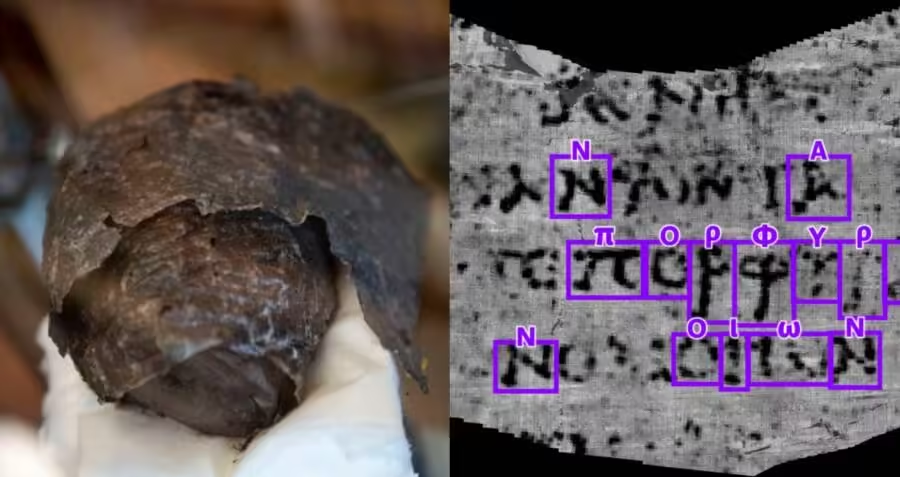Table of Contents
AI unlocks the secrets of an old Herculaneum scroll
ROME — Buried beneath ash following the catastrophic eruption of Mount Vesuvius in 79 A.D., hundreds of papyrus scrolls have preserved their secrets for ages. But with artificial intelligence, archaeologists are now able to decode portions of the old text.
The Herculaneum papyri, found among thousands of other artifacts in the ruins of a villa believed to have belonged to Julius Caesar’s father-in-law, Lucius Calpurnius Piso Caesoninus, are a collection of about 1,000 scrolls that were carbonized during the eruption.
They were named after the location where they were buried, Herculaneum, an old Roman town south of Pompeii that was also devastated by the explosion. They were discovered by farm workers in the eighteenth century.
Previous attempts to decipher their secrets have been unsuccessful because the majority of the scrolls crumbled and turned into carbonized ash. But after a monk laboriously unfolded some of them over several decades, it was discovered that they contained Greek-language philosophical writings.
The Herculaneum scrolls’ contents can only currently be read by piecing together the thousands of fragments from the scrolls that fell apart, according to Richard Janko, a distinguished professor of classical studies at the University of Michigan, who made this statement to NBC News on Thursday. .
He went on, “It’s like assembling a mosaic, and not many people are willing to do it.” Therefore, it might take 500 years to understand what they say. Hopefully, using this method will make things a lot simpler and faster.
The discovery was made subsequent to the start of an international competition aimed at expediting the reading of the documents. The Vesuvius Challenge promised a $1 million reward to the first person to solve the puzzle and decipher the remaining 270 closed scrolls; the majority of these are kept at a Naples library, some 8 miles west of Herculaneum.
“The chemistry of medieval ink is not the same as that of ink from the ancient world. Even when detected by the X-ray, it remains mostly undetectable to the unaided eye,” he stated. “Yet, we are aware that the tomography records details regarding the ink.”
We did develop an artificial intelligence-based method in 2019 that let us “see” the ink, but our team was small and the system required a lot of data. In order to speed up the job and scale up our procedures, we created the challenge,” he continued.
Eighteen teams competed in all, and the finest entries were forwarded to a global team of papyrologists who evaluated each entry for readability and proceeded to transcribe the writings.
Ultimately, the panel of judges, which included Janko, determined that three students from the United States, Julian Schilliger from Switzerland, and Youssef Nader from Egypt should split the $700,000 top prize.
After training machine-learning algorithms on the scans, the three individuals managed to decipher 2,000 letters from the scroll. The scroll was divided into sections after a CT scan was used to create a 3D scan of the writing. The text could subsequently be deciphered thanks to the use of a machine learning model, an AI application, which identified the areas that had been inked.
One of the competition’s sponsors, Nat Friedman, claimed on the social networking site X that the winners had read “new text from the ancient world that has never been seen before” from the final 15 columns of the first scroll after the winners were revealed earlier. this week.
He remarked, “The author writes here about music, food, and how to enjoy life’s pleasures. The author is probably the Epicurean philosopher Philodemus.” The author disparages unidentified ideological opponents in the concluding section, saying they “have nothing to say about pleasure, either in general or in particular.” These opponents could be the stoics.
The method was dubbed “revolutionary” by Giancarlo del Mastro, a papyrology professor at Naples’ University Campania Luigi Vanvitelli.
Del Mastro, who also assisted in judging the Vesuvius Challenge, stated, “We were astonished.” “We have been interpreting them literally day and night, but what excites me even more is that we can now unveil the information that has been concealed in the papyrus for nearly two millennia thanks to this technique.”
read also: With this new technology, building a quantum computer has never been easier.
old Herculaneum scroll old Herculaneum scroll old Herculaneum scroll old Herculaneum scroll old Herculaneum scroll old Herculaneum scroll old Herculaneum scroll old Herculaneum scroll old Herculaneum scroll
Secrets of ancient Herculaneum scroll deciphered by AI (msn.com)

